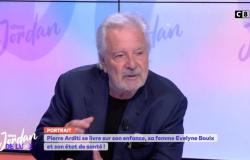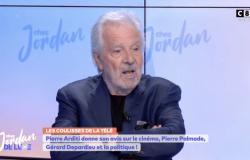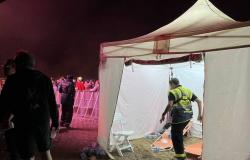Every year since 1980, a new work has been imagined by an artist, free to express their creativity at the tennis tournament.
Created in 1980, the first poster for the Roland-Garros tournament was initiated by the president of the French Tennis Federation, Albert Canet. The objective? Linked contemporary art and sport. The poster is designed by a French or foreign artist before being available in several advertising products such as t-shirts. The artists are free, they have no constraints apart from remaining within the codes of tennis. From the figurative to the abstract, the inspirations are numerous. Here are the most notable.
nineteen eighty one
Beige tone, recognizable silhouette, the poster, created by Madrid painter Eduardo Arroyo, refers to the silhouette of the legendary Swede Björn Borg. Long before Rafael Nadal, he triumphed over world tennis in the 1980s.
Eduardo Arroyo – Galerie Lelong/FFT 1981
1990
Clay court and serving player, Claude Garache united these two fundamental elements of the Roland-Garros tournament for the official poster of 1990. She is the first female figure represented.
Claude Garache – Galerie Lelong/FFT 1990
1995
The heart of Daniel Lipski. This American assembled two tennis rackets on a blue background to create a heart. The original sculpture is held by the Roland-Garros museum.
Donald Lipski – Galerie Lelong/FFT 1995
2003
We had to wait twenty-three years. In 2003, the American Jane Hammond was the first female artist to make the official poster of the tournament. His work, produced on coated paper, represents several players in action. All on a clay background. She will be followed by her compatriot Kate Sheperd in 2007 then by the Indian artist Nalini Malini in 2010. There are also two French artists. They will distinguish themselves later: Fabienne Verdier will direct that of 2018 and Louise Sartor that of 2022
Jane Hammond – Galerie Lelong/FFT 2003
2005
She got people talking. When the Catalan Jaume Plensa came to Roland-Garros, he saw the stadium under the snow. His visit inspired his poster. This is a complete break with the color codes of the tournament. It is the only poster in forty-five years to be offered in black and white. We can read a text from Rabelais’s Quart livre, in the background: “The words when they are uttered (…) freeze and turn into ice in the coldness of the air, we no longer hear them. .. Now the rigor of winter having passed, the serenity and sweetness of good weather having arrived, they melt and make themselves heard.
Jaume Plensa – Galerie Lelong/FFT 2005
2012
Coming from the modest art movement, the 2012 poster got people talking. She was surprised. Imagined around comic book characters, it is the creation of Hervé Di Rosa, the founder of the modest arts movement in France. It is a combination of flashy green and pink colors. A bullet in the center of the poster passes through the big drawn mouths.
Hervé Di Rosa – Galerie Lelong/FFT 2012
2017
Its original no longer exists. Brazilian artist Viz Muniz took a photo of his sand creation before erasing it according to the rite of mandalas of Tibetan monks. Like that of 1990, we see the shadow of a player on clay. But this figure is black sand.
Vik Muniz – Galerie Lelong / FFT 2017
2024
This year, French photographer Paul Rousteau signs the official poster for the tournament. Its creation echoes the Olympics. Its particularity lies in the design called “innovative” by the FFT. The artist relied on artificial intelligence for this creation.
Paul Rousteau / FFT 2024






